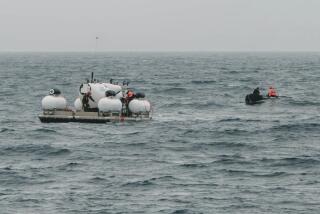Oil industry’s answers frustrate federal panel
- Share via
Reporting from Houston — Federal investigators are showing increasing frustration at murky or nonresponsive answers from oil industry officials as they parse the causes of the worst offshore oil spill in U.S. history.
Since the hearings began in May, three BP officials with intimate knowledge of events leading up to the April 20 explosion on the Deepwater Horizon drilling rig have declined to testify before a joint Coast Guard and Interior Department panel, which convened again Wednesday. One repeatedly cited a medical excuse and two invoked their constitutional right not to produce testimony that could incriminate themselves.
Coast Guard Capt. Hung Nguyen, the even-keeled lead investigator, appeared to be losing his patience at Wednesday’s hearing in Houston as he asked ever-more pointed questions about high-ranking officials’ knowledge of past disasters and their company practices.
Nguyen expressed particular agitation at answers given by a London-based BP vice president for drilling, Harry Thierens, who testified that he had not been following news accounts of the investigation into the cause of the Deepwater Horizon disaster in the Gulf of Mexico.
Nguyen asked Thierens about safety lessons learned from a near-blowout of a BP well in 1999 and two events in 2005: the near-sinking of the BP oil platform Thunder Horse in the gulf and the BP refinery explosion in Texas City, Texas, that killed 15 people.
Thierens said he wasn’t aware of the near-blowout and could not list lessons learned from the 2005 incidents.
Prompted by Nguyen, Thierens said he couldn’t recall details of the 1988 explosion of the Occidental Petroleum Corp.-owned oil platform Piper Alpha in the North Sea.
“What if I were to tell you that there was a gas leak, which ignited and caused an explosion and killed 167 people in the North Sea? And there was a public inquiry into that incident?” Nguyen said.
“I do recall, yeah,” Thierens said.
“And there were a lot of lessons learned out of that, and the British government made major changes in the way the gas and oil industry operated in the North Sea. Do you remember any of that, sir?” Nguyen asked.
“No, I don’t,” Thierens said.
Nguyen expressed frustration, questioning whether industry managers had learned from past disasters or simply accepted periodic casualties.
“Is it something that, you know, people say that this kind of casualty happens every 20 years?” Nguyen said. “This is what I’m seeing. There are a lot of things that were identified 20 years ago that are still happening right here with the Deepwater Horizon.”
Thierens did not answer.
Investigators were also dissatisfied about the confusing chain of command aboard the rig.
Nguyen characterized the command structure as a three-legged stool, giving authority on key decisions to three people — the captain and a manager, both employees of rig owner Transocean Ltd., and a well-site leader from BP, which leased the rig.
“I just don’t see how everything gets coordinated,” Nguyen said.
Thierens said he lacked a “thorough understanding” of the command structure, a response that left Nguyen unhappy.
“Someone has got to be in charge,” Nguyen said. “And someone has got to have an overall picture of what’s going on of not only the vessel, but for the entire … company operation and the industry. I just don’t have a clear picture in my mind of who it is. That’s why I’m trying to ask you.”
Thierens also testified that he was not notified of changes made in the blowout preventer, a key safety device on the oil rig designed to stop the surge of oil from below the seafloor. The changes hampered efforts to take control of the well, he said.
And Mark Hay, a Transocean supervisor, rebutted testimony from July in which rig electronics technician Mike Williams alleged that Hay scolded him for repairing a gas safety valve that had been put in bypass mode. When operational, the device automatically cuts off unexpected flows of gas from the well into the rig, which could ignite and explode.
Hay denied telling Williams that the valve had been in bypass mode for five years and that the entire Transocean fleet ran that way. Hay said he did tell Williams to keep it in bypass mode until parts arrived to fix the valve problem.
In Washington, S. Elizabeth Birnbaum, the former head of the now-defunct Minerals Management Service, which oversaw drilling in federal waters, told a presidential investigative commission that she had “deep regret” for the disaster and acknowledged that her agency’s spill response plans had been “woefully lacking.”
Kim Geiger in the Washington bureau contributed to this report.
More to Read
Sign up for Essential California
The most important California stories and recommendations in your inbox every morning.
You may occasionally receive promotional content from the Los Angeles Times.














